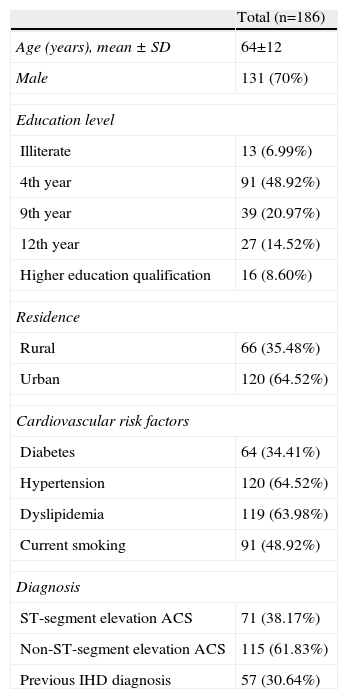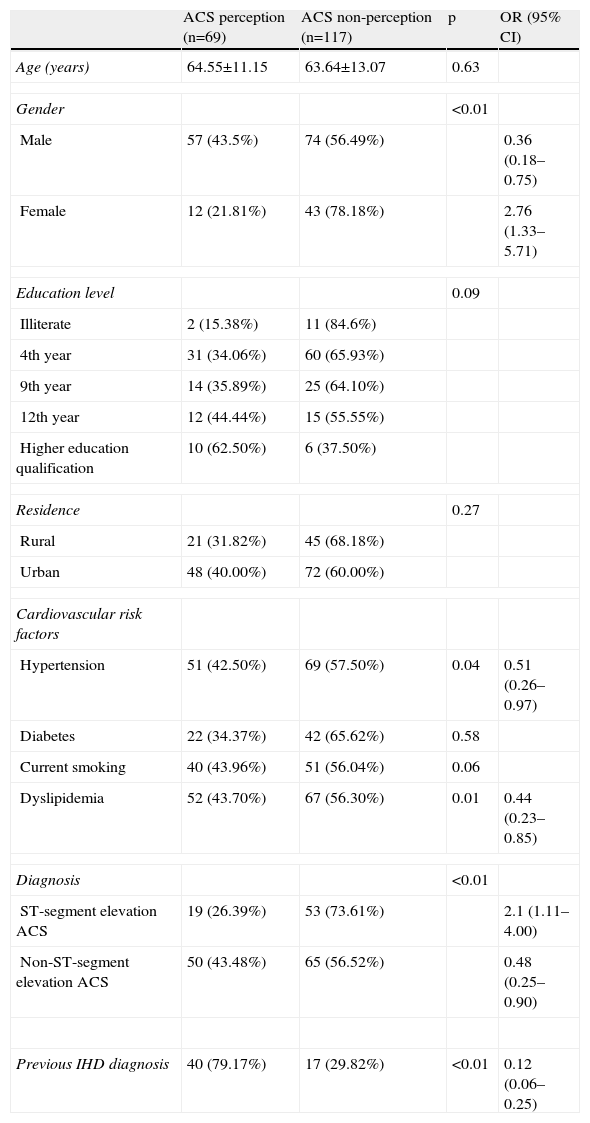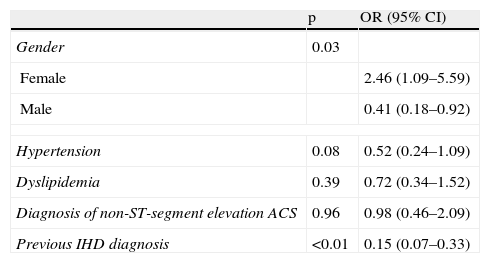Interpretation of the symptoms of acute coronary syndrome (ACS) can influence the time of hospital admission and negatively affect patients’ prognosis. We decided to explore illness perception and its predictors among patients with ACS.
MethodsWe conducted a retrospective analysis of all consecutive patients with ACS admitted to the cardiology department of a tertiary hospital between January and September 2011. Data were obtained from patients’ medical records and telephone interviews.
ResultsOne hundred and eighty-six patients with ACS (mean age 64±12 years; 70% male) were included. The majority (62.6%) had no perception of ACS until informed by their doctor. Only 26% of patients with ST-segment elevation myocardial infarction had perception of cardiac disease. Among those who had perception, 82.6% were men and 58% had a previous diagnosis of ischemic heart disease (IHD). Gender and previous diagnosis of IHD were independent predictors of ACS perception, with male gender and patients with previous IHD having greater illness perception. No association was found between ACS perception and age or residence area (rural vs. urban).
ConclusionsThe illness perception of ACS patients needs to be improved, independently of sociodemographic factors. An educational program for the general population, but particularly for women and individuals without a past history of IHD, focusing on the alert signs for ACS, may help to improve illness perception in this setting.
A interpretação dos sintomas da síndrome coronária aguda (SCA) pode influenciar o tempo da admissão hospitalar e afetar negativamente o prognóstico. Decidimos explorar a perceção da doença e os seus preditores em doentes com SCA.
MétodosEfetuamos uma análise retrospetiva de todos os doentes consecutivamente admitidos no departamento de cardiologia de um hospital terciário com SCA, entre janeiro e setembro de 2011. A informação foi obtida através dos registos clínicos e entrevista telefónica.
ResultadosCento e oitenta e seis doentes (idade média de 64±12 anos; 70% homens) com SCA foram incluídos. A maioria (62,6%) dos doentes não tinha perceção da SCA atéàinformação médica. Apenas 26% dos doentes com enfarte agudo do miocárdio com supradesnivelamento do segmento ST tiveram perceção da doença cardíaca. Entre aqueles que tiveram perceção, 82,6% eram homens e 58% tinha um diagnóstico prévio de doença cardíaca isquémica (DCI). O sexo e o diagnóstico prévio de DCI foram preditores independentes da perceção da SCA, tendo o sexo masculino e os doentes com DCI prévia uma perceção superior. Nenhuma associação foi encontrada relativamente à idade e área de residência (rural versus urbana).
ConclusõesA perceção de doença dos pacientes com SCA precisa de ser melhorada, independentemente de fatores sociodemográficos. Um programa educacional que abranja a população geral, particularmente as mulheres e aqueles sem antecedentes de DCI, e que foque os sinais de alerta para a SCA poderá ser útil para melhorar a perceção dos sintomas neste contexto.
Acute coronary syndrome (ACS) is a significant cause of mortality and morbidity worldwide. Coronary reperfusion therapies, thrombolysis and antiplatelet drugs have been consistently shown to be more effective at reducing mortality and the development of important clinical complications if patients are treated with these interventions as promptly as possible.1 The shorter the interval between symptom onset and treatment, the better the resulting cardiac function.2,3 According to a Portuguese single-center registry of 223 ST-elevation ACS patients, the median interval between symptom onset and first medical contact was 104 minutes and only 6% of patients seek medical help in the first 30 minutes.2 A significant number of patients delay seeking medical care because of their inability to recognize typical symptoms and signs of ACS.4 Mistaken interpretation of symptoms was found to be associated with significant delay in seeking treatment5–10 and long prehospital delays lead to lost opportunities for early risk stratification and management, leading to increased mortality and morbidity.11,12
The aim of the present study was to explore patients’ perception of the clinical presentation of ACS and to identify predictors of awareness of typical symptoms and signs. This knowledge is important to understand illness perception, what aspects of it could be modified and in what patient groups educational interventions could improve perception.
MethodsWe conducted a retrospective study of all consecutive ACS patients admitted to the cardiology department of a Portuguese tertiary center between January and September 2011. A total of 370 patients were reviewed and only patients with typical oppressive chest pain at presentation were included. Those who had atypical symptoms or initial symptoms inside the hospital (n=160) were excluded, as well as patients who died during index hospitalization or follow-up (n=5). A sample of 205 patients was analyzed and clinical data were retrospectively obtained from patients’ medical records. Telephone interviews were performed after hospital discharge (time between discharge and call was variable) by a doctor asking patients about their perception of symptom onset. The question for all patients was: “Did you consider the possibility of a heart problem when your chest pain started?” Patients who answered affirmatively were classified as having perception of ACS symptoms. Twenty patients did not have the cognitive ability to understand the question and were excluded from the final analysis. No other questions relating to perception and patient behavior (for example time before calling for help) were investigated, in order to minimize recall bias.
Past ischemic heart disease (IHD) was defined as a history of ACS, coronary revascularization or positive ischemic stress test.
The demographic and clinical characteristics of patients who had perception of ACS were compared with those of patients who did not, using the chi-square test for categorical variables and the t test for continuous variables. Logistic regression models were used to estimate odds ratios (OR) and 95% confidence intervals (CI). Variables with p<0.05 in univariate analysis were included in a multivariate model. The statistical analysis was performed using SPSS® version 19. The ethics committee of Hospital São João approved the study.
ResultsOne hundred and eighty-six patients with ACS (mean age 64±12 years and 70% male) were included. The baseline characteristics of the population are profiled in Table 1. ACS presentation was unstable angina in 12.3%, ST-segment elevation myocardial infarction (MI) in 38.2%, non-ST-segment elevation MI in 42.8% and undetermined ECG location MI in 6.4%. Most subjects had low educational levels (49% with only four years of schooling) and lived in an urban center (64%).
Baseline characteristics of the study population.
| Total (n=186) | |
| Age (years), mean ± SD | 64±12 |
| Male | 131 (70%) |
| Education level | |
| Illiterate | 13 (6.99%) |
| 4th year | 91 (48.92%) |
| 9th year | 39 (20.97%) |
| 12th year | 27 (14.52%) |
| Higher education qualification | 16 (8.60%) |
| Residence | |
| Rural | 66 (35.48%) |
| Urban | 120 (64.52%) |
| Cardiovascular risk factors | |
| Diabetes | 64 (34.41%) |
| Hypertension | 120 (64.52%) |
| Dyslipidemia | 119 (63.98%) |
| Current smoking | 91 (48.92%) |
| Diagnosis | |
| ST-segment elevation ACS | 71 (38.17%) |
| Non-ST-segment elevation ACS | 115 (61.83%) |
| Previous IHD diagnosis | 57 (30.64%) |
ACS: acute coronary syndrome; IHD: ischemic heart disease.
Hypertension and dyslipidemia were the most common cardiovascular risk factors (64% each) and 31% had a previous diagnosis of IHD.
The majority (62.6%) of patients did not have the perception that they were suffering an ACS until informed by their doctor. Only 26% of patients with ST-segment elevation MI had perception of cardiac disease. Among those who had perception, 82.6% were men and 58% had a previous diagnosis of IHD.
On univariate analysis (Table 2), male gender, dyslipidemia, hypertension, non-ST-segment elevation ACS and previous IHD were associated with ACS perception. No association was found with age even after stratification by age groups (<65 years, 65–75 years, >75 years: 35.4%, 43.3%, 30% ACS perception, respectively; p=0.41). Residence (rural or urban) also had no influence on illness perception. A non-significant (p=0.09) relation was found to the five levels of education, but this may be due to the small number of subjects with a higher education qualification. Dividing the population into two groups by education level (illiterate+4th year+9th year, 32.9% ACS perception and 67.1% ACS non-perception vs. 12th year+higher education qualification, 51.2% ACS perception and 48.8% ACS non-perception) showed that a higher education qualification was associated with better perception of ACS (p=0.03).
Clinical predictors of ACS perception in the study population.
| ACS perception (n=69) | ACS non-perception (n=117) | p | OR (95% CI) | |
| Age (years) | 64.55±11.15 | 63.64±13.07 | 0.63 | |
| Gender | <0.01 | |||
| Male | 57 (43.5%) | 74 (56.49%) | 0.36 (0.18–0.75) | |
| Female | 12 (21.81%) | 43 (78.18%) | 2.76 (1.33–5.71) | |
| Education level | 0.09 | |||
| Illiterate | 2 (15.38%) | 11 (84.6%) | ||
| 4th year | 31 (34.06%) | 60 (65.93%) | ||
| 9th year | 14 (35.89%) | 25 (64.10%) | ||
| 12th year | 12 (44.44%) | 15 (55.55%) | ||
| Higher education qualification | 10 (62.50%) | 6 (37.50%) | ||
| Residence | 0.27 | |||
| Rural | 21 (31.82%) | 45 (68.18%) | ||
| Urban | 48 (40.00%) | 72 (60.00%) | ||
| Cardiovascular risk factors | ||||
| Hypertension | 51 (42.50%) | 69 (57.50%) | 0.04 | 0.51 (0.26–0.97) |
| Diabetes | 22 (34.37%) | 42 (65.62%) | 0.58 | |
| Current smoking | 40 (43.96%) | 51 (56.04%) | 0.06 | |
| Dyslipidemia | 52 (43.70%) | 67 (56.30%) | 0.01 | 0.44 (0.23–0.85) |
| Diagnosis | <0.01 | |||
| ST-segment elevation ACS | 19 (26.39%) | 53 (73.61%) | 2.1 (1.11–4.00) | |
| Non-ST-segment elevation ACS | 50 (43.48%) | 65 (56.52%) | 0.48 (0.25–0.90) | |
| Previous IHD diagnosis | 40 (79.17%) | 17 (29.82%) | <0.01 | 0.12 (0.06–0.25) |
ACS: acute coronary syndrome; CI: confidence interval; IHD: ischemic heart disease; OR: odds ratio.
Multiple linear regression analysis, using variables associated with ACS perception (gender, hypertension, dyslipidemia, diagnosis of non-ST-segment elevation ACS, previous IHD) showed that gender and previous diagnosis of IHD were independent predictors of ACS perception, with males and patients with previous IHD having better illness perception (Table 3).
Multiple linear regression analysis of factors associated with ACS perception.
| p | OR (95% CI) | |
| Gender | 0.03 | |
| Female | 2.46 (1.09–5.59) | |
| Male | 0.41 (0.18–0.92) | |
| Hypertension | 0.08 | 0.52 (0.24–1.09) |
| Dyslipidemia | 0.39 | 0.72 (0.34–1.52) |
| Diagnosis of non-ST-segment elevation ACS | 0.96 | 0.98 (0.46–2.09) |
| Previous IHD diagnosis | <0.01 | 0.15 (0.07–0.33) |
ACS: acute coronary syndrome; CI: confidence interval; IHD: ischemic heart disease; OR: odds ratio.
The proportion of patients with illness perception of ACS in our study was very low (37%), but a similar result was observed in a Chinese cohort,13 in which of the 12 common symptoms of MI, on average only 3.37 were recognized by the subjects.
Various factors have been identified in the literature regarding the decision-making process of healthcare-seeking behavior among ACS patients. However, most studies analyze predictors of prehospital delay and not predictors of symptom perception. Although prehospital delay was not analyzed in our population, it is to be expected that patients with ACS perception will seek medical care earlier, as observed in several studies.9,10,14
Investigators assessing gender differences related to prehospital delay have reported conflicting results. Although several studies have shown that female gender was a significant variable in predicting prehospital delay,15–17 many others found no significant differences between genders.5–8,18,19 Some authors explain the longer delays in women by their lower frequency of chest pain,20,21 atypical symptoms being more common in women, which may reduce ACS perception. In our cohort, female gender was associated with worse perception of ACS symptoms, with a two-fold increase in failure to identify cardiac symptoms. Since our population had chest pain presentation, atypical ACS presentation did not explain our results in the female group, suggesting that women had less awareness of cardiac symptoms even with typical chest pain. The reason for this phenomenon is unknown.
Like other researchers,5,15,18 we found no influence of age on ACS perception. However, published series are not consistent on this subject, with some authors reporting a positive relation between older age and greater delays in seeking acute medical care.7,8,16,17,19
It was expected that experience of previous ACS or having a personal history of coronary heart disease would increase knowledge and hence correct interpretation of symptoms. Our results showed that the absence of a previous IHD diagnosis was associated with a six-fold increase in incorrect symptom interpretation. Other studies showed that previous cardiac events were associated with a greater likelihood of seeking early medical care.10,14,17 This may explain why only 26% of patients with ST-segment elevation MI had perception of cardiac disease, since ST-elevation ACS is more often the first coronary event.
There appeared to be a positive relation between higher education levels and correct interpretation of ACS symptoms in our cohort, but a larger sample would be necessary to confirm this statistically. On the other hand, significantly better illness perception was not observed in patients living in an urban center. Similarly, other studies report little or no relation between prehospital delay and socioeconomic status.5,19,22
The present study seems to be the first in which ACS-related illness perception and its predictors have been analyzed in a sample of Portuguese patients.
The main limitation of this study is related to the possibility of recall bias, because the subjects’ experiences of ACS symptoms were elicited retrospectively after hospital discharge. The small sample size could also have influenced the results, as well as the study's retrospective nature, in which important variables were difficult to analyze, particularly delays before hospital admission.
Despite its limitations, this study offers a preliminary insight into patients’ knowledge about alert signs of ACS. Future research should evaluate this issue employing a prospective design, able to assess real information about symptoms and signs of ACS in the Portuguese population. This data will be important for developing public education in order to encourage patients to seek early medical care and thereby improve treatment.
ConclusionsOur results suggest that patients’ knowledge of ACS symptoms is inadequate and could be a significant risk factor that correlates with their delay in seeking for treatment. The perception of symptoms of patients with ACS needs to be improved, independently of sociodemographic factors. An educational program for the general population, but particularly for women and individuals without a past history of IHD, focusing on symptom awareness and recognition of ACS, may help to improve illness perception in this setting.
Ethical disclosuresProtection of human and animal subjectsThe authors declare that no experiments were performed on humans or animals for this study.
Confidentiality of dataThe authors declare that they have followed the protocols of their work center on the publication of patient data.
Right to privacy and informed consentThe authors have obtained the written informed consent of the patients or subjects mentioned in the article. The corresponding author is in possession of this document.
Conflicts of interestThe authors have no conflicts of interest to declare.








